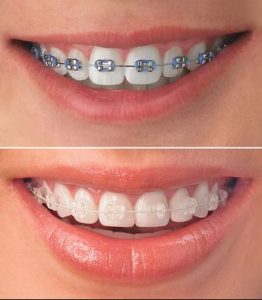
Orthodontics is the specialty of dentistry that is concerned with the study and treatment of malocclusions (improper bites), which may be a result of tooth irregularity, disproportionate jaw relationships, or both. Orthodontic treatment can focus on dental displacement only, or can deal with the control and modification of facial growth. In the latter case it is better defined as “dentofacial orthopedics”.
Orthodontic treatment can be carried out for purely aesthetic reasons with regards to improving the general appearance of patients’ teeth. However, there are orthodontists who work on reconstructing the entire face rather than focusing exclusively on teeth. Irregular teeth have been a major problem. For comprehensive orthodontic treatment, most commonly, metal wires (arch wires) are inserted into orthodontic brackets which can be made from stainless steel or a more aesthetic ceramic material. The wires interact with the brackets to move teeth into the desired positions.
Additional components—including removable appliances (“plates”), headgear, expansion appliances, and many other devices—may also be used to move teeth and jaw bones. Functional appliances, for example, are used in growing patients (age 5 to 14) with the aim of modifying the jaw dimensions and relationship if these are altered. This therapy, termed Dentofacial Orthopedics, is frequently followed by fixed multibracket therapy (“full braces”) to align the teeth and refine the occlusion. After a course of active orthodontic treatment, patients will typically wear retainers, which maintain the teeth in their improved positions while surrounding bone reforms around them.
The retainers are generally worn full-time for a short period, perhaps 6 months to a year, and then part-time (typically nightly during sleep) for as long as the orthodontist recommends. It is possible for the teeth to stay aligned without regular retainer wear. However, there are many reasons teeth will crowd as a person ages, whether or not the individual ever experienced orthodontic treatment; thus there is no guarantee that teeth will stay aligned without retention. For this reason, many orthodontists prescribe part-time retainer wear for many years after orthodontic treatment.
Metal Braces
Clear Braces
When most people think of metal braces they think of the big clunky braces of the past. They were extremely uncomfortable and more than capable of cutting your lips. From a cosmetic point of view they were, at best, unattractive and are wholly responsible for the stigma attached to braces today. However, times have changed and so have braces.
Modern braces are smaller and more comfortable than old fashioned braces. They have what is called a low profile design, which is less irritating to your lips. They also have special contours to make your orthodontic treatment go faster and be less painful.
Braces now use new plastics and bonding adhesives rendering metal bands a distant, somewhat painful memory. Wire and brackets can be “super-glued” directly onto the teeth making them far more secure. There are even some braces that seem “invisible”.
Clear braces offer a unique advantage over conventional metal appliances. The material composition and design allows an uncompromising level of care and enable you to look good during treatment. Many people may not even be aware that you’re wearing braces at all.
Braces no longer need to be dull. We have a full line of colored elastics with which you can mix ‘n match, make a fashion statement or show home team spirit with matching team colors. With each monthly visit you will have the opportunity to change colors and keep your look fresh.